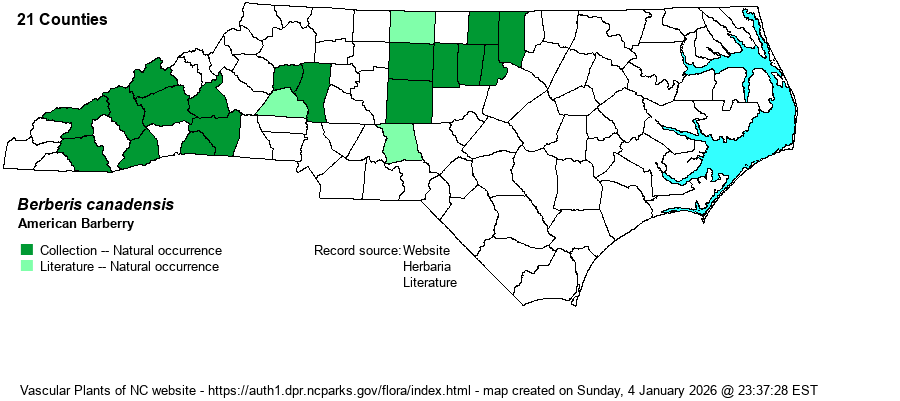| Author | P. Miller | |
| Distribution | Scattered over much of the Mountains and Piedmont, but no records yet for the northern Mountains or northwestern Piedmont, despite many records from neighboring VA. Ranges eastward to Granville and Montgomery counties.
This species has a quite spotty range, seemingly absent (or very rare) in many areas. It ranges north to (formerly) PA, southern WV and MO, and south to central GA and AL, mostly being absent from the Coastal Plains. Despite the scientific name epithet, it does not occur in Canada.
| |
| Abundance | Rare in both the Mountains and Piedmont. Surprisingly very rare or absent from the northwestern portion of the state. This species, as do other barberries, serves as an alternate host for wheat rust. In some parts of the range this has led to physical eradication of the shrubs, though this might not have been the case in NC, at least not in recent decades. It is a State Special Concern species. | |
| Habitat | It is restricted to sites of higher pH soils, over mafic rock. It prefers dry or mesic and somewhat open sites, such as Diabase Glades, Basic Oak-Hickory Forest, bluffs and rocky forests, and occasionally in floodplain forests, at least in openings. |
| Phenology | Blooms in April and May, and fruits in September and October. | |
| Identification | This is a deciduous shrub that grows to 3-6 feet tall. It has obovate to oblanceolate (widest near the tip) leaves, to about 2 inches long, that are rather thick (looking like an evergreen species) and have scattered sharp, spiny teeth along the margins of the leaves (but not toward the base). In addition, at the leaf nodes is a three-pronged set of thorns. The flowers are fairly small, but as they are yellow and grow in dangling clusters, the inflorescence is rather attractive and conspicuous. Normally, the species is not difficult to identify from other native shrubs, but care must be taken because there are several non-native Berberis species that are similar (though seldom seen in NC), but the main exotic here -- B. thunbergii -- has leaves that are entire, with no spiny teeth. | |
| Taxonomic Comments | None
| |
| Other Common Name(s) | Allegheny Barberry | |
| State Rank | S2 | |
| Global Rank | G3G4 | |
| State Status | SC-V | |
| US Status | | |
| USACE-agcp | | |
| USACE-emp | | |

